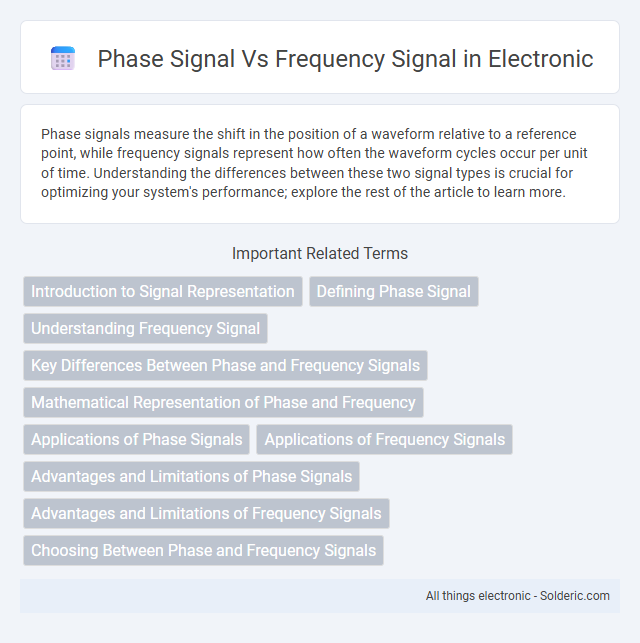Phase signals measure the shift in the position of a waveform relative to a reference point, while frequency signals represent how often the waveform cycles occur per unit of time. Understanding the differences between these two signal types is crucial for optimizing your system's performance; explore the rest of the article to learn more.
Comparison Table
| Feature | Phase Signal | Frequency Signal |
|---|---|---|
| Definition | Variation in the phase angle of a waveform over time. | Variation in the number of cycles per second (Hz) of a waveform. |
| Measurement | Phase shift measured in degrees or radians. | Frequency measured in hertz (Hz). |
| Signal Representation | Represents phase deviation relative to a reference. | Represents rate of oscillation or repetition. |
| Applications | Phase modulation, synchronization, phase-locked loops. | Frequency modulation, spectrum analysis, communication systems. |
| Sensitivity | Highly sensitive to timing and synchronization errors. | Sensitive to changes in signal period or cycles. |
| Detection Methods | Phase detectors, demodulators. | Frequency counters, spectrum analyzers. |
| Signal Stability | Phase noise affects phase signal stability. | Frequency drift affects frequency signal stability. |
Introduction to Signal Representation
Phase signals represent variations in the phase angle of a waveform relative to a reference, capturing time shifts in periodic signals crucial for applications like radar and communications. Frequency signals describe how often a waveform cycles per unit time, with frequency domain analysis enabling the identification of signal components and spectral content. Both representations are essential in signal processing, providing complementary insights for modulation, demodulation, and system performance analysis.
Defining Phase Signal
Phase signal represents the position of a wave cycle at a given point in time, measured as an angle in degrees or radians. It is crucial for understanding timing relationships in oscillatory systems, distinguishing it from frequency signals that quantify how often cycles repeat per second. Your analysis of phase signals enables precise synchronization and modulation in communication, radar, and signal processing applications.
Understanding Frequency Signal
A frequency signal represents the rate at which a waveform repeats per second, measured in Hertz (Hz), indicating how fast the signal oscillates. Unlike phase signals that describe the instantaneous angle or position within one cycle, frequency signals quantify the overall periodicity, crucial for applications like communication systems and signal processing. Accurate frequency detection enables synchronization, modulation, and efficient data transmission across various electronic and telecommunication devices.
Key Differences Between Phase and Frequency Signals
Phase signals represent the relative position within a waveform cycle, measured in degrees or radians, while frequency signals indicate how many cycles occur per second, measured in hertz (Hz). Your understanding of these signals is crucial for applications like communication systems, where phase affects signal timing and synchronization, and frequency determines signal pitch and bandwidth. Phase signals vary instantaneously relative to a reference point, whereas frequency signals quantify the rate of change of phase over time.
Mathematical Representation of Phase and Frequency
Phase signals are mathematically represented as the angle th(t) in the sinusoidal function x(t) = A cos(ot + th(t)), where th(t) represents the instantaneous phase shifting the waveform in time. Frequency signals are described by the time derivative of the phase, f(t) = (1/2p) dth(t)/dt, indicating how rapidly the phase changes and corresponding to the instantaneous frequency. This relationship highlights that frequency is the rate of change of phase, making phase and frequency fundamentally interconnected in signal analysis.
Applications of Phase Signals
Phase signals are critical in telecommunications for synchronization and data modulation, enabling accurate timing in systems like GPS and radar. In power systems, phase signals help monitor and control electrical load balancing and fault detection. Precise phase measurements are also essential in audio processing and imaging technologies for noise reduction and signal clarity.
Applications of Frequency Signals
Frequency signals are widely utilized in communications systems for encoding and transmitting data, enabling efficient modulation techniques such as Frequency Modulation (FM) and Frequency Shift Keying (FSK). These signals play a crucial role in radar and sonar technologies, where precise frequency changes help determine object distance and speed. Your ability to analyze and generate frequency signals supports advanced applications in wireless networks, signal processing, and instrumentation.
Advantages and Limitations of Phase Signals
Phase signals offer high precision in timing applications, enabling accurate synchronization in communication systems and radar technology. Their limitation lies in susceptibility to noise and distortion, which can degrade signal clarity and affect overall system performance. Your system's effectiveness depends on balancing these advantages with potential phase ambiguity and complexity in signal processing.
Advantages and Limitations of Frequency Signals
Frequency signals offer high resilience to noise and distortion, making them ideal for long-distance communication and reliable data transmission in varying environmental conditions. Their ability to carry information over wide bandwidths enhances signal clarity and reduces error rates compared to phase signals. However, frequency signals may require more complex hardware for modulation and demodulation, increasing system cost and power consumption.
Choosing Between Phase and Frequency Signals
Choosing between phase and frequency signals depends on the application's sensitivity to time or spectral accuracy. Phase signals offer precise time alignment and are ideal for synchronization tasks in communication systems. Frequency signals provide better spectral stability and are preferred in applications requiring consistent frequency measurements like radar and spectroscopy.
phase signal vs frequency signal Infographic

 solderic.com
solderic.com